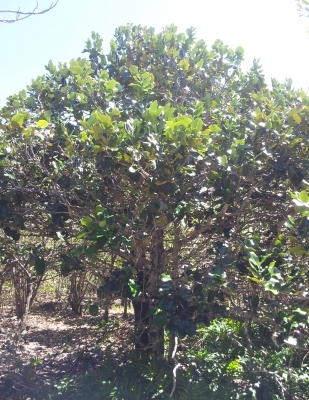Diospyros egrettarum
I.Richardson
Ebenaceae
Common Name:

A small tree growing on Mauritius
Photograph by: S Molteno
Creative Commons Zero, Public Domain Dedication

A small tree growing on Mauritius
Photograph by: S Molteno
Creative Commons Zero, Public Domain Dedication

Fruit and seeds
Photograph by: Abu Shawka
Creative Commons Attribution-Share Alike 3.0

Cross-section of the wood, showing the black heartwood
Photograph by: Abu Shawka
Creative Commons Attribution-Share Alike 3.0
General Information
Diospyros egrettarum is a shrub or a tree that can grow 3 - 5 metres tall. It is much branched below, the branches mostly inserted at right angles[
933- Title
- Notes on Diospyros (Ebenaceae) in the Mascarene Islands
- Publication
- Kew Bulletin Vol. 34 No. 4 pp. 723 - 735
- Author
- Richardson I.B.K.
- Publisher
- Royal Botanic Gardens, Kew; London
- Year
- 1980
- ISBN
-
- Description
- An article in a Botanical Journal, it describes the 14 native species of Diospyros in the Mascarenes.
].
The tree was at one time extensively exploited for its wood, to the extent that it has become almost extinct[
338- Title
- IUCN Red List of Threatened Species
- Publication
-
- Author
-
- Website
- http://www.iucnredlist.org/
- Publisher
-
- Year
- 0
- ISBN
-
- Description
- A list of plants under threat and facing possible extinction, usually with brief details of the threats and information on habitat.
].
Once a dominant coastal ebony, the species is now reduced to fewer than 10 individuals on the mainland and a larger viable population on Ile aux Aigrettes, a coral island off the east coast. The plant is classified as 'Critically Endangered' in the IUCN Red List of Threatened Species(2013)[
338- Title
- IUCN Red List of Threatened Species
- Publication
-
- Author
-
- Website
- http://www.iucnredlist.org/
- Publisher
-
- Year
- 0
- ISBN
-
- Description
- A list of plants under threat and facing possible extinction, usually with brief details of the threats and information on habitat.
].
Known Hazards
None known
Botanical References
933- Title
- Notes on Diospyros (Ebenaceae) in the Mascarene Islands
- Publication
- Kew Bulletin Vol. 34 No. 4 pp. 723 - 735
- Author
- Richardson I.B.K.
- Publisher
- Royal Botanic Gardens, Kew; London
- Year
- 1980
- ISBN
-
- Description
- An article in a Botanical Journal, it describes the 14 native species of Diospyros in the Mascarenes.
Range
Africa - Mauritius.
Habitat
Exposed coastal areas[
933- Title
- Notes on Diospyros (Ebenaceae) in the Mascarene Islands
- Publication
- Kew Bulletin Vol. 34 No. 4 pp. 723 - 735
- Author
- Richardson I.B.K.
- Publisher
- Royal Botanic Gardens, Kew; London
- Year
- 1980
- ISBN
-
- Description
- An article in a Botanical Journal, it describes the 14 native species of Diospyros in the Mascarenes.
].
Properties
| Conservation Status | Critically Endangered |
| Other Uses Rating |  |
| Habit | Tree |
| Height | 4.00 m |
| Self-fertile | No |
| Cultivation Status | Wild |
Cultivation Details
A dioecious species, both male and female forms need to be grown if fruit and seed are required[
933- Title
- Notes on Diospyros (Ebenaceae) in the Mascarene Islands
- Publication
- Kew Bulletin Vol. 34 No. 4 pp. 723 - 735
- Author
- Richardson I.B.K.
- Publisher
- Royal Botanic Gardens, Kew; London
- Year
- 1980
- ISBN
-
- Description
- An article in a Botanical Journal, it describes the 14 native species of Diospyros in the Mascarenes.
].
Edible Uses
None known
Medicinal
None known
Other Uses
Due to a shortage of supply, the tree is not normally harvested for its wood, but it was at one time heavily harvested, almost to extinction, for wood and for fuel[
338- Title
- IUCN Red List of Threatened Species
- Publication
-
- Author
-
- Website
- http://www.iucnredlist.org/
- Publisher
-
- Year
- 0
- ISBN
-
- Description
- A list of plants under threat and facing possible extinction, usually with brief details of the threats and information on habitat.
].
Propagation
Seed - in general the seed of Diospyros species has a very short viability and so should be sown as soon as possible. The flesh should be removed since this contains germination inhibitors. Sow the seed in a shady position in a nursery seedbed. The sowing media for ebony uses soil and fine sand at the ratio 3:1. The seed is planted horizontally or vertically with the radicle end down, with a sowing depth of 1 - 1½ times the thickness of seed. Distance between the seeds is 3 - 5cm. Seeds are very sensitive to desiccation during germination and early growth, so must be regularly watered at this time. Normally the seed will germinate after one week[
].
As a rule fresh seeds have a high percentage of fertility. The seedlings develop long taproots at an early stage, often before any appreciable elongation of the shoot takes place. The growth of the seedling is decidedly slow [
652- Title
- The Silviculture of Indian Trees
- Publication
-
- Author
- Troup. R.S.
- Website
- http://www.biodiversitylibrary.org
- Publisher
- Oxford, at the Clarendon Press
- Year
- 1921
- ISBN
-
- Description
- An excellent treatment.
].
If you have any useful information about this plant, please leave a comment. Comments have to be approved before they are shown here.




 Useful Tropical Plants Database 2014 by
Ken Fern,
web interface by
Ajna Fern
with help from
Richard Morris.
Useful Tropical Plants Database 2014 by
Ken Fern,
web interface by
Ajna Fern
with help from
Richard Morris.